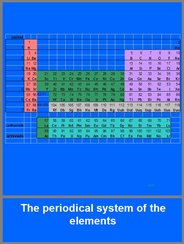
1. Examples of atoms
A structured overview of the family of the atoms implies that the variation in the number of electrons per nucleus is superimposed on the chart of the nuclei. In practice, the number of neutrons has little influence on the structure of the electron shell and a simpler approach can be followed that focuses on the electron shells, because these are responsible for the reactive properties. One of the first overviews of the atom family was published by Mendeleev and has become known as the periodical system of the elements (see figure). I consider it an interesting consequence of the operator hypothesis that Hydrogen no longer is regarded as an atom. However strange this may seem, the reason is simple. Hydrogen does not show a hypercycle in its nucleus. Instead the operator approach considers the Hydrogen atom with electron shell as a special atom-like interaction system.

2. Links to interesting sites with information about atoms
http://www.webelements.com/(the periodic table of the elements)
http://www.tmeg.com/esp/e_orbit/orbit.htm(historic atom models, shell chart, and very modern orbit pictures!!!)
http://www.colorado.edu/physics/2000/waves_particles/wavpart2.html(do it yourself: start an electron orbit around a proton)
http://www.colorado.edu/physics/2000/applets/a2.html (a limited but interesting periodic table, shows for a selected atom all the electrons in dynamic orbits around the nucleus, shows a dynamic movie of the protons and neutrons in the nucleus, shows prize of the material, weight and discoverer)

